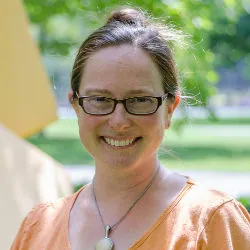
http://bit.ly/2efaNHY October 21, 2016
Dear industry colleagues:
I understand some of the reasons why you took your Ph.D. and ran: the glamour and mystery of Silicon Valley. The opportunity to work with smart colleagues on products that make a difference in people’s lives. The excitement of a rapidly changing field. The opportunities to change jobs and take sabbaticals. The hours. The perks. The paycheck.
And, being in industry means never having to write a grant proposal.
I, too, recoiled at the thought of a research career in which I would spend my time writing grant proposals, managing grad students, and writing more proposals so I can continue to support my grad students, never touching a line of code. I, too, considered a career in industry, albeit briefly. Instead, I’ve pursued a career teaching computer science (CS) at liberal arts colleges, along with a little research and more administration than I ever thought I would. Ten years and still going strong!
Liberal arts colleges differ from research universities in some key ways:
- Liberal arts colleges focus on undergraduate education. A liberal arts college does not grant Ph.D.’s. Some offer masters’ or professional degrees, but these programs tend to be quite small.
- Liberal arts students learn many different ways of thinking. In a typical engineering program, major requirements might constitute 60% of a student’s coursework, or even more. At a liberal arts college, major requirements typically comprise 25%–35% of a student’s coursework, with the remainder spent exploring other disciplines, and perhaps developing depth in a second discipline through a double major or minor.
- To earn tenure, liberal arts faculty are typically expected to demonstrate excellence in teaching, an active program of scholarship, and contributions to their institution and profession. Faculty might spend 60% of their time on teaching, 30% on scholarship, and 10% on service.
Teaching at a liberal arts college has more in common with working in the tech industry than you might think:
- The glamour. Silicon Valley is glamorous, but liberal arts profs are mini-celebrities among their students and often in the towns where they work. "Scientist" and "teacher" are the fourth and fifth most-admired professions in the U.S. (http://bit.ly/2gcVrzb). Chances are good you’ll be the only local expert on your research area, and many other things besides. It’s a small pond, but we are all big fish!
- The mystery. Most people don’t understand our jobs any more than they understand yours.
- Working with smart people. Most academics are pretty smart. Working at a liberal arts college means nearly all of your colleagues are not computer scientists, which means you can learn a lot just by talking with them.
- Meetings. We have meetings just like you do. What a great opportunity to learn from our diverse and thoughtful colleagues! I’ve gotten to know some really cool people by serving on committees with them.
- Making things. Teaching is all about creating learning experiences. I still write code: I write my students’ homework assignments.
- Getting your hands dirty. Undergrad researchers need supervision. Chances are good you will find yourself working beside them, whether to teach them how to do it right or figure out what they did wrong. You’ll get to investigate bugs you never even dreamed possible!
- Making a difference. I admit it: nobody uses the things we academics make. Except our students. Strangely enough, students mostly do what we tell them to do; they seem to trust our instructions are intended for their learning. Sometimes, students and alumni come back and tell us how much they learned from our classes, projects, and assignments. Not to get sentimental, but in the last month I’ve gotten notes from two alumni thanking me just for spending time with them.
- The excitement of a rapidly changing field. It seems I never teach the same course twice. What we teach in academia is influenced by what you are doing in industry, so we’re changing along with you, and the body of foundational knowledge in CS is still expanding. For example, between studying computer architecture as an undergrad in 1996 and teaching it for the first time in 2011, pipelining and superscalar architectures made it into the textbooks. No big deal, right? CS is also expanding into interdisciplinary applications. Liberal arts colleges value learning across disciplines, and our relatively flat organizational structures facilitate collaboration. Even if the technology and content of a course haven’t changed, the students have.
- Changing jobs. It seems like folks in Silicon Valley change jobs every 2–3 years. I change jobs all the time. Every semester I am teaching different courses on a different schedule. Every year I have different administrative responsibilities. Bored? Frustrated? Wait three months!
- Sabbaticals. Sabbaticals are a unique opportunity in the tech industry, compared to most other industries. (As fast as everyone changes jobs, no one will notice a few months’ gap on your résumé.) By contrast, sabbaticals are de rigueur for faculty. The traditional sabbatical is one year out of every seven, but some colleges offer more than that. The truth is, we need it—time to renew, reflect, research, write, and rest. Undergraduates are young. We’re old. They only stay for four years. We’d die if we tried to keep up with them all the time.
- Summers. You don’t get summers off? We do! Well, not exactly off; most liberal arts college faculty have nine-month contracts, so we are on our own over the summer. Some use this time to take on short-term contract work, or write summer salary into their (gasp!) grant proposals. Most write, research, travel, supervise students, and/or prepare for the coming academic year. It’s important to rest during our summers, too, even if we sometimes feel guilty for not getting as much done as we planned. Fortunately, our nine-month salaries are spread out over all 12 months of the year, so we don’t starve.
- The hours. Like you, we sometimes work long hours to meet release deadlines. That means not just meeting conference deadlines, but also getting big assignments out, finalizing grades, or making recommendations for hiring. Much of our work falls into a routine, and we don’t get brownie points for arriving early or staying late. No one is watching (except our students, who have been known to remind the less self-disciplined of us to go home and eat dinner). Much of our work is our own choice—usually how we do it, and often what we do. When I’ve had the longest hours, I’ve been doing things I enjoy: meeting interesting people, teaching new classes, and working with my students. Also, see the previous "Summers."
- The perks. You know all those perks that Google and Facebook offer? They are trying to create a college-like environment. Why not go for the original? Free lunch might not be offered every day, but it’s often an incentive for attending seminars and committee meetings. The dining hall is cheap. Candidates and speakers need to be taken out to dinner at fancy restaurants. Why is there so much alcohol at faculty events? To get us to stop working on our own things and talk to each other. Many colleges offer inexpensive housing near campus for new faculty, so you can roll out of bed and walk to class just like your students do (though maybe not in your pajamas). Trust me, after a couple of years, you won’t want to be quite so close to campus.
- The paycheck. I won’t lie: academic paychecks are nowhere close to Silicon Valley paychecks. Though computer scientists tend to earn more than most faculty, some of your new grads will earn a higher salary than you do. There are no annual bonuses or stock options in academia. On the other hand, the same salary goes a lot farther in Grinnell, IA, or Walla Walla, WA, than in Silicon Valley, and in the eternal words of Jessie J: "It’s not about the money."
- Funding research. While most liberal arts colleges will help you write external grant proposals—and I have many colleagues who have received external research grants—few liberal arts colleges require faculty to seek external grants. If your equipment needs are modest, there is often internal funding to support students. Internal proposals are reviewed not by other computer scientists (or by the C suite), but by colleagues in the liberal arts. This means as long as you can explain it convincingly and eventually get it published, you can do pretty much whatever kind of research you want. There’s no need to reframe your real interests to fit a corporate or national research program.
I haven’t written this just to hear myself talking (though it sometimes seems faculty are prone to that). CS is facing a crisis in hiring. An increasing number of new Ph.D.’s are bound for industry, which means faculty positions are going unfilled. Whatever good experiences you had as a CS undergrad, students today are not necessarily getting the same experience. Fewer faculty means bigger classes, less hands-on mentoring, and a chillier climate for women and minorities. We need you to help us make undergraduate education everything it should be.
Thinking long term, if more Ph.D.’s don’t return to the academy, there won’t be enough graduates capable of taking all those high tech jobs. Thinking even longer term, if there are not enough CS graduates getting Ph.D.’s, the whole pipeline could grind to a halt (http://stanford.io/2fQl8EL). Liberal arts colleges make a real contribution to maintaining the Ph.D. pipeline: in measuring yield of science students who go on to earn Ph.D.’s (http://bit.ly/2fKvUkL), baccalaureate colleges are second only to "research universities with very high research activity," and constitute the majority of the list of top 50 institutions. It is critical we get new faculty who can fill open positions at liberal arts colleges.
Please consider a return to academia, whether forever or just for a year. I promise, there will still be jobs in Silicon Valley when you go back.
Signed,
Your undergrad professors
(We always believed in you!)



Join the Discussion (0)
Become a Member or Sign In to Post a Comment